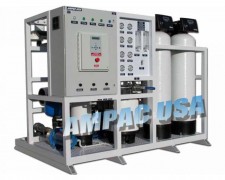Reverse Osmosis for the Food Industry - AMPAC USA

LOS ANGELES, October 31, 2019 (Newswire.com) - Most of the reverse osmosis treatment plants are situated on the whims of the ocean or water bodies. So are many industries including the food processing industry. Agriculture alone takes up more than half of our freshwater reserved as vegetables, fruits and grains require it to grow. However, one of the major concerns of at least 33 percent of consumers is whether the food processed is safe for consumption.
“There's always the fear of diseases like E. Coli that can cause serious health problems. Food processing industries, therefore, remain careful in their approach and dread an outbreak. Every system and process they use has to be up to the health standards specified by regulatory boards and the facility has to remain hygienic. As a precautionary measure, almost every food processing industry has systems that are run on Reverse Osmosis,” says Sammy Farag, CEO of AMPAC USA.
Reverse osmosis is a process used for purification of incoming water to be used for a wide range of purposes. But it is a big asset for industries manufacturing goods that will be consumed like the beer breweries, beverage, dairy and especially the food industry.
How Does RO Help In Food Processing?
Osmosis is a natural process of flow of water or liquid through a semi-permeable membrane when two solutions of differing concentrations are placed on either side. The liquid passes from a solution of lower concentration to higher concentration in order to balance the amount of salt in each.
Reverse Osmosis was developed as a result of it that puts pressure on the water to be on the lower concentration side. This semi-permeable membrane acts as a filter for stopping harmful chemicals, organic materials, sediments, and other impurities to pass through. The resulting water is fresh and free of any contaminants.
“These reverse osmosis filters are used in almost every purification purpose and in every sector of industries. It is even used for household purposes. Food processing is very important considering it deals with the health of the people directly and so uses this method of water purification to use it in various functions of production,” adds Farag.
In what ways does the food processing industry use RO?
In the Food Processing industry, water is used in almost every aspect and corner of the factory. Boiling, washing the raw materials, cleaning the systems and utensils used, cooling the food hence prepared and various other activities. The majority of these activities directly deal with the raw materials like potatoes, tomatoes, chili, pepper, beans, etc. Take a simple example of the canning of diced tomatoes.
- Raw tomatoes are washed thoroughly
- They are passed through the dicing machine which has to be absolutely clean and is kept so with water
- The tomatoes are then poached in boiling water and
- Finally, the product is pressure canned in a water bath.
Now that the activities are decided and their importance understood, food processing industries are left with 3 choices.
- To choose a source, using municipality supplied tap water has mineralization and even if you treat it for pathogens and bacteria, the mineralization gives a funny taste to the product.
- Treating the municipal supply with chlorine the organic matter present in it dies but the taste again varies.
- Opt for reverse osmosis applied processes to purify the incoming water for balanced health and taste.
“Here reverse osmosis comes in to play. The procedure eliminates every contaminant including chlorine to give ready to use healthy and safe drinking water. This, in turn, gives palatable results,” says Farag. “A system should be installed based on the complete analysis of the supply you receive. It gives you consistent results and the customers a consistent taste with a healthy product.”
Which RO Is Best For A Food Processing Industry?
Based on the size of the industry, a company can choose between a commercial RO for small and medium scale industries and industrial RO for the facilities operating at a much larger scale. These systems are available in automatic and manual setting but with a lot going on in the facility, it is suggested to get an automated system with less manual supervision.
These come very well equipped with reverse osmosis systems and give the quality of water customized for the facility’s needs. Also, both commercial and industrial RO come in wide ranges of capacities to choose from. But before a choice is made, it is important to understand what the supply is made of. The best decision would be to get an expert to do an analysis of the incoming water based on which the best strategy of RO systems to be operated for the best results will be suggested.
About the Author:
AMPAC USA is a manufacturer of water treatment systems used around the globe for quality drinking water. The company has an experience of over 30 years, uses the latest technology to provide a standard, reliable products and works with experts to give the best possible service.
Source: AMPAC USA
